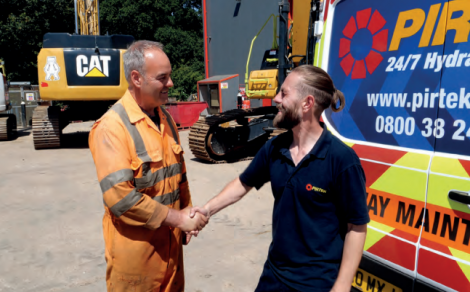- Home » Editorial » Hydraulics
Prioritising hydraulic health and safety

Martyn Smart, QHSE Manager at Pirtek UK and Ireland takes a look at prioritising hydraulic health and safety in plant hire and construction
The construction industry is considered to be high risk due to the number of fatal and non-fatal injuries that occur each year. The dynamic nature of the profession along with the operation of heavy machinery in often hazardous environments, means workers are frequently exposed to a wide range of risks. Last year, The Health and Safety Executive (HSE) reported 59,000 cases of non-fatal work-related injury, with RIDDOR identifying that a large portion of accidents were the result of handling equipment; slips, trips, and falls; and being struck by moving objects.
Whilst these figures are still high compared to other industries such as manufacturing and transportation, steps have been taken in recent years to improve health and safety across construction sites. In the UK, for example, the introduction of new health and safety regulations and guidelines enforce all construction projects to have a health and safety plan in place to help manage risks from start to finish. Technology developments including the use of drones, smart vests, and hard hats with location tracking help better protect workers from injury. And more and more companies are making health and safety training a mandatory requirement for all staff in tandem with driving education and encouraging awareness of its importance.
As part of these efforts to improve health and safety, special attention must be paid to hydraulic systems as well as the importance of using trained experts when they breakdown.
Hydraulics in construction
If you walk on a construction site, nearly all of the machinery you will encounter will be powered by modern hydraulics. From bulldozers and excavators through to power shovels, cranes, and graders. Not only do hydraulics deliver power to large onsite equipment but they are also crucial in the manufacture of many of the construction products that are delivered to site. In a nutshell, the world of construction relies on hydraulics to keep operations moving to meet the stringent deadlines of a project.
Whilst the machinery itself will have operations guidance and regulations surrounding how it is used (it must be separated from pedestrians, it can only be operated by trained personnel, and it needs to be inspected regularly to prevent accidents) only competent technicians should carry out repairs and maintenance. If a hydraulic breakdown should occur, it might be tempting for onsite staff to try and fix it themselves in efforts to minimise downtime or save money. However, this is a risky strategy to employ and can lead to life-changing injuries for those carrying out the work without the required expertise.
Dangers of hydraulic hoses
A hydraulic hose allows fluid to flow from one component to another, ensuring it is able to move unimpeded to keep the hydraulic system moving. Constructed from flexible rubber and wire, a hydraulic hose has multiple layers to give it strength and durability but it is not infallible. Without professional maintenance it can naturally sustain damage and degrade over time, causing it to fail before its average five-year life expectancy. Old age, high operating temperatures, abrasions, chemical erosion, poor fittings, and pressure overload are some of the common reasons for hoses needing to be replaced before this time.
-
PPMA 2025
23 September, 2025, 9:30 - 25 September, 2025, 16:00
NEC, Birmingham UK -
Advanced Engineering Show 2025
29 October, 2025, 9:00 - 30 October, 2025, 16:00
NEC, Birmingham UK










